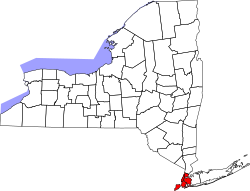New York City Department of Sanitation Police
| New York City Department of Sanitation (Police Enforcement Unit) | |
|---|---|
 Shield of the New York City Department of Sanitation (Police Enforcement Unit) | |
| Common name | NYC Dept of Sanitation (Police Enforcement Unit) |
| Agency overview | |
| Formed | 1936 |
| Preceding agency |
|
| Jurisdictional structure | |
| Operations jurisdiction | New York, United States |
 | |
| Map of New York City Department of Sanitation (Police Enforcement Unit)'s jurisdiction | |
| Size | 468.9 square miles (1,214 km2) |
| Population | 8,274,527 |
| Legal jurisdiction | New York City |
| General nature |
|
| Operational structure | |
| Headquarters | Brooklyn, NY |
| Peace Officers | approx 70 members as of 2018 |
| Commissioner responsible |
|
| Agency executive |
|
| Parent agency | New York City Department of Sanitation |
| Facilities | |
| Patrol Cars | Ford Fusion |
| Website | |
| DSNY Official Site | |
The New York City Department of Sanitation (Police Enforcement Unit) is the law enforcement arm of the New York City Department of Sanitation (DSNY), primarily responsible for regulating, enforcing and investigating sanitation-related offenses within the City of New York.
Overview[]
The New York City Department of Sanitation (Police Enforcement Unit) comprises approximately 70 members including officers, lieutenants, inspectors, and chiefs. Members are drawn from sanitation workers, supervisors, superintendents, and chiefs who have volunteered to undertake law enforcement duties. They retain their original civil service title, depending on their rank while assigned to the unit.
Training and typical equipment[]
New York City Department of Sanitation (Police Enforcement Unit) recruits are required by the New York State Municipal Peace Officer Training Council to undergo and pass a 16-week training course before they become peace officers within the Sanitation Law Enforcement Division. The training given in this course includes training in penal law, police science, discipline, powers of a peace officer, radio use, defensive tactics, unarmed and armed self-defense, physical training, chemical training, handcuffing techniques, and arrest procedures, among other subjects.
Upon successfully graduating, the New York City Department of Sanitation (Police Enforcement Unit) grants trainees peace officer status to all officers. Officers carry and use firearms, handcuffs, pepper spray, expandable ASP baton, radios, and other related law enforcement and public safety equipment. Once assigned, officers undergo 400 hours of on-the-job field training with experienced personnel before being issued permanent assignments.
All officers also undergo continuing education training to re-qualify on equipment and learn about changes in law and department procedures.
Powers and authority[]
New York City Sanitation officers are Special Patrolman and are appointed in connection with special duties of employment, and such designation confers limited Peace Officer powers upon the employee pursuant to New York State Criminal Procedure Law § 2.10(27). The exercise of these powers is limited to the employee's geographical area of employment and only while such employee is actually on duty as listed in Chapter 13 subsection (C): Special Patrolmen[1]
They enforce sanitation laws and strive to improve the quality of life in NYC. Some of the areas of focus are:
- illegal dumping,
- environmental-related summonses,
- theft of recyclables,
- private sanitation truck enforcement,
- illegally abandoned vehicles,
- littering, public urinating and
- improper disposal of solid waste, just to name a few.
Other enforcement operations include regulating and enforcing private transfer stations within the city, and the transportation of waste within the city. They can also issue various summonses which include Environmental Control Board summonses, Vehicle and traffic law summonses, NYC Parking Violation Summonses and NYC Criminal Court summonses.

Ranks[]
There are several ranks within the DSNY Police, which are as follows:
| Title | Insignia | Uniform shirt color |
|---|---|---|
| Chief | White | |
| Inspector | White | |
| Lieutenant | White | |
| Peace Officer | Silver Shield | Dark blue |
Officers with the rank of Lieutenant and above wear white shirts, gold shields, capbadges and capbands. Each ranks has its own shield (similar to other NYC police agencies).[2]
Operations[]
Working both in uniform and in plainclothes, officers have responsibilities ranging from summonsing residents for mixing recyclable and non-recyclable trash to investigating the illegal dumping of refuse, commercial and toxic waste.
One notable example occurred in 1996 when Environmental Enforcement Officers assisted the New York City Police Department (NYPD) with investigating the death of a sanitation worker who was killed when he was struck in the face by deadly hydrofluoric acid that was mixed with ordinary garbage. The suspect was arrested by detectives from the NYPD for aggravated manslaughter.
Divisions[]
There are a number of units within the New York City Department of Sanitation (Police Enforcement Units), with each unit handling different law enforcement functions:
- The Citywide Illegal Dumping Task Force headed by an Inspector
- The Uniformed New York City Department of Sanitation (Police enforcement unit)
NYC Sanitation also has workers assigned to the New York City Business Integrity Commission and to New York City Emergency Management.[3][4]
See also[]
- New York City Department of Sanitation
- List of law enforcement agencies in New York
- Law enforcement in New York City
References[]
- ^ https://codelibrary.amlegal.com/codes/newyorkcity/latest/NYCrules/0-0-0-78042
- ^ https://www.sanitationfoundation.org/blog/uniforms
- ^ "About BIC". City of New York. Archived from the original on April 8, 2009. Retrieved April 21, 2009.
- ^ "NYC Emergency Management". City of New York. Archived from the original on April 17, 2009. Retrieved April 21, 2009.
External links[]
- Law enforcement agencies of New York City
- Specialist police departments of New York (state)